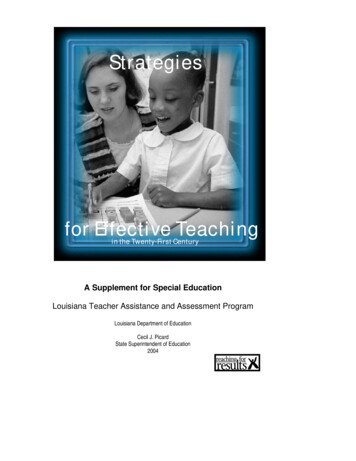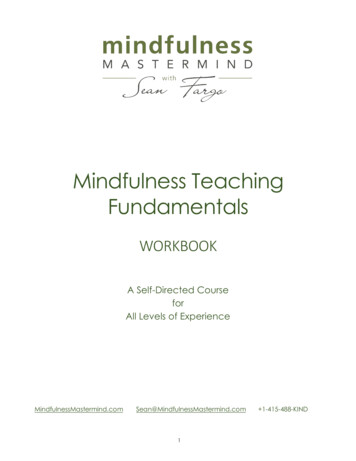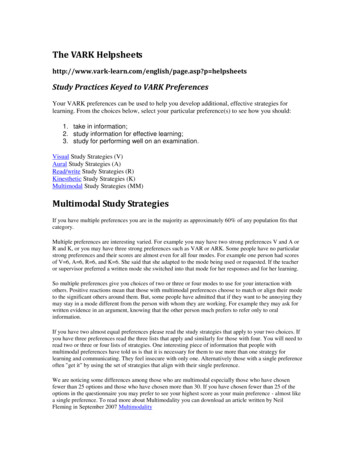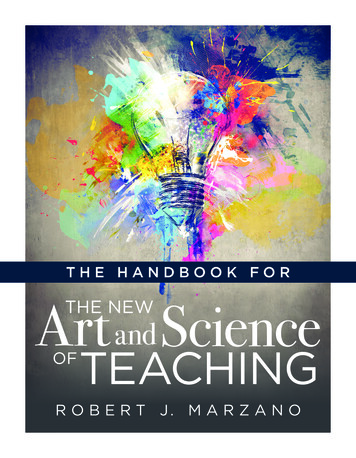
Transcription
Strategiesin the Twenty-First Centuryfor Effective Teachingin the Twenty-First CenturyA Supplement for Special EducationLouisiana Teacher Assistance and Assessment ProgramLouisiana Department of EducationCecil J. PicardState Superintendent of Education2004
Table of ContentsPreface3Performance Domain I: Planning77Component A: The teacher plans effectively for instruction.Performance Domain II: ManagementComponent A: The teacher maintains an environment conducive tolearning.Component B: The teacher maximizes amount of time available forinstruction.Component C: The teacher manages learner behavior to provideproductive learning opportunities.Performance Domain III: InstructionComponent A: The teacher delivers instruction effectively.Component B: The teacher presents appropriate content.Component C: The teacher provides opportunities for studentinvolvement in the learning process.Component D: The teacher demonstrates ability to assess and facilitatestudent academic MNOPQ1313Alternate Assessment Planning MatrixCoaching SheetsActivities ListEcological InventoryNine Types of AdaptationsBest Practices Checklist for Students with Low Incidence DisabilitiesIEP Review ChecklistGeneral Safety ChecklistStructuring ActivitiesSample Task AnalysisIEP GridMAPSCommunication Analysis FormInclusion Planning SheetWays to Say “Good”Parent Preferences for Home/School CommunicationInclusive Education Video ProgramsThe web sites and links in this document were checked and found to be accurate andavailable as of September 2003.2
PREFACEPurpose of the Strategies for Effective Teaching for Special EducatorsThe long-range goal of Louisiana’s teacher professional accountability programs is toenhance student learning by providing opportunities for teachers to strengthen skill areasand by identifying those aspects of teaching performance that may need improvement.This approach to professional development is the key to improving teacher performance.Strategies for Effective Teaching in the 21st Century is intended to be used by schooladministrators, in collaboration with classroom teachers, to improve specific teachingskills. The strategies to be utilized should be discussed by the teacher and the principal(in collaboration with an assistance and/or assessment team, if appropriate) and mutuallyagreed upon. Strategies, which provides suggestions and resources for improvement, iskeyed to the Louisiana Components of Effective Teaching and is used as a resource byteachers as they prepare for assessment.Strategies for Effective Teaching for Special Educators, a supplement to Strategies forEffective Teaching in the 21st Century, focuses on the particular needs of teachers inspecial education and provides suggestions and resources for improvement.Format of the SupplementThis Supplement is indexed by the attributes of the Louisiana Components of EffectiveTeaching. Each attribute is accompanied by suggested Strategies, Evidence ofCompletion, and Resources. Attributes are included under their respective Components.The Strategies are specific suggestions for gaining knowledge about and practicingteaching skills, and a variety of activities are included.Reading activities direct teachers to the research on teaching effectiveness. Theseactivities encourage teachers to review and think about critical teaching conceptsand principles.Observational activities permit teachers to view alternative teaching strategies andbehaviors as demonstrated by peers or allow peer teachers to observe what istaking place in another’s classroom. (A peer teacher may be any teachingcolleague who possesses the desired teaching behavior and is willing to share hisor her knowledge with others.) When the observations are summarized anddiscussed, they provide the teacher opportunities for reflective practice.Implementation activities are classroom-based suggestions that teachers canimmediately try out in daily instruction.3
All strategies are proactive. The strategies are things teachers can do, either alone orcollaboration with the principal or colleagues. The strategies presented are not meantbe comprehensive. They may serve as starting points for developing other strategies.particular strategy may be modified to suit the needs of the principal and the teacher.strategy may also be repeated.intoAAThe selection of strategies must also be appropriate for the developmental level of thestudents in the teacher’s classroom. Extra care should be taken in selecting strategies tobe implemented in classrooms with very young children or children with special needs.The suggested Evidence of Completion consists of observable means by which teachersand principals can document professional development activities. Principals can use theevidence as a record of progress for Professional Growth Plans.The Resources section of the Strategies for Effective Teaching manual lists thosematerials and persons essential for the successful completion of the activity. Theprincipal and the teacher should be jointly responsible for ensuring that the necessaryresources are available for selected professional development activities. Under nocircumstances should a strategy be chosen that necessitates a teacher spend personalfunds for materials unless the teacher willingly agrees to participate.Many of the journal articles and books listed in the Resources column are easilyobtainable from state, local or university libraries. Materials that are not available on-sitecan be requested through interlibrary loan. Appendix M at the back of the originalStrategies for Effective Teaching manual gives directions on how to contact appropriatelibrary personnel. Materials that are available through the Regional Service Centers arelisted in Appendix K of the manual. For a review of how to retrieve ERIC documentsfrom the ERIC database, see Appendix U of the manual.A number of strategies presented in this manual require that peer teachers conductobservations or be observed. This type of teacher collaboration for professionalimprovement may require use of “release time.” Principals are encouraged to providerelease time when warranted. However, the extent to which release time is provided mustbe determined by the principal, based on the resources available at the building level. Analternative to release time is the use of videotape or tape recording. Peer teachers can“observe” each other’s classrooms through the use of well-placed video cameras or audiotape recorders. Then the tapes can be reviewed and feedback given, as time warrants.General Resources for Working with TeachersIt is suggested that every special education teacher have access to a copy of Strategies forEffective Teaching in the 21st Century as well as this supplement. Numerous strategies inthe general manual can be adapted for use in the special education classroom. Inaddition, the Appendices in the manual contain many aids that special educators will finduseful.4
As principals work collaboratively with classroom teachers they should seek to build acore of professional reading and teaching materials. A number of available professionalbooks and videotapes are good general resources for working with teachers on thedevelopment of teaching skills. A partial list would include:Acheson, K. A., and Gall, M.D. (1992).teachers (3rd ed.). New York: Longman.Techniques in the clinical supervision ofBlasé, J., and Kirby, P.C. (1992). Bringing out the best in teachers. Newbury, CA:Corwin.Glickman, C.D. (1990). Supervision of instruction: A developmental approach (2nd ed.).Boston: Allyn and Bacon.Gordon, S. (1991). How to help beginning teachers succeed. Alexandria, VA:Association for Supervision and Curriculum Development.Hofmeister, A., and Lubke, M. (1990). Research into practice: Implementing effectiveteaching practices. Boston: Allyn and Bacon.Hunter, M. (1993). Enhancing teaching. New York: Macmillan.Newbert, G.A. (1988). Improving teaching through coaching. Bloomington, IN: PhiDelta Kappa. (Fastback #277).Opening doors: An introduction to peer coaching (Video). Alexandria, VA: Associationfor Supervision and Curriculum Development.Reyes, R. (1991). The ten commandments for teaching. Washington, DC: NationalEducation Association.Robbins, P. (1991). How to plan and implement a peer coaching program. Alexandria,VA: Association for Supervision and Curriculum Development.Schell, L.M., and Burden, P. (1992). Countdown to the first day of school. Washington,DC: National Education Association.Shuman, R.B. (1989). Classroom encounters: Problems, case studies, and solutions.Washington, DC: National Education Association.Silverman, R., Welty, W.M., and Lyon, S. (1992). Case studies for teacher problemsolving. New York: McGraw-Hill.Wong, H.K., and Wong, R.P. (1991). The first days of school: How to be an effectiveteacher. Sunnyvale, CA: Wong Publications.5
In addition to the references listed above, special education resource books can offer amultitude of teaching and planning suggestions. A few recent titles include:Gable, R.A., and Warren, S.F. (1993). Strategies for teaching students with mild to severemental retardation. Baltimore, MD: Brookes.Louisiana Department of Education. (2001). General education access guide. BatonRouge: Louisiana Department of Education.Putnam, J.W. (1993). Cooperative learning and strategies for inclusion. Baltimore, MD:Brookes.Ryndel, D. L., and Alper, S. (1996). Curriculum content for students with moderate andsevere disabilities in inclusive settings. Upper Saddle River, NJ: Putnam.Westling, D. L., and Fox, L. (2000). Teaching students with severe disabilities. NeedhamHeights, MA: Allyn and Bacon.Many other excellent titles are available. Check with the special education supervisor orwith your Regional Service Center to get other titles on special education topics.The National Education Association offers numerous publications and videotapes ontopics such as classroom management, teaching methods, and special education. PhiDelta Kappa (PDK) makes available the “Fastback,” research-based summaries ofeducational topics including teaching techniques.6
Performance Domain I: PlanningComponent A. The teacher plans effectively for instruction.I.A.1. Specifies learner outcomes in clear, concise objectivesStrategy 1Evidence of CompletionResourcesClear concise objectivesstem from goals thatclearly target individualstudent needs in a varietyof current and futureenvironments.Completed AlternateAssessment: StudentPlanning MatrixIEP objectives linkedto/reflect needs fromplanning MatrixSelect one student fromyour class roll. Meet withthe student’s instructionalteam and discuss goals andobjectives/skill areas thatwould be relevant for thestudent in each curriculumarea (e.g., EnglishLanguage Arts,Mathematics, Science,Social Studies, Self-help,Social,Vocational.)General Education AccessGuide (2001), Section II:Curriculum Issues for Studentsin Alternate Assessment (referto the Matrix and CoachingSheets) available throughspecial educationdirectors/supervisors andhttp://www.louisianaschools.netSample completed AlternateAssessment: Student PlanningMatrix and Instructions forCompleting the AlternateAssessment Matrix (AppendixA)Sample Coaching Sheets(Appendix B)Complete an AlternateAssessment: StudentPlanning Matrix. With theIEP team, prioritize yourskill areas to target for thestudent’s IEP.IEP teamMentorSeyler, A.B., Buswell, B.E.(2001). IEP: Involved EffectiveParents, PEAK Parent Center(www.PEAKparent.org)7Deleted: )
Component A. The teacher plans effectively for instruction.I.A.2. Includes activity/environments that develop objectivesStrategy 1Evidence of CompletionResourcesPlan at least two activities eachfor two different objectives fromyour students’ IEPs. Identifyyour next steps by using thefollowing questions whenreviewing the activities with yourpeer and/or mentor: Original and rewrittenactivitiesPeer teacherMentorStudents without disabilitiesCastagnera, E., Fisher, D.,Rodifer, K., Sax, C. (2003).Deciding What to Teach andHow to Teach It:Connecting StudentsThrough Curriculum andInstruction(www.PEAKparent.org).Is this activity directlyrelated to the objective?Will this activity help thestudent make progresstoward the objective?Is the activity appropriatefor the student?Is the activity ageappropriate?Does the activity promotestudent dignity?Have accommodations,modifications, andsupports beenincorporated in activity?Have nondisabled peersbeen incorporated in theactivity?Has assistive technology(both low and high tech)been incorporated into theactivity as needed?Have opportunities forrepeated practice beenbuilt into the activity?Have opportunities forgeneralization beenincorporated into theactivities?Is this an activity a nondisabled student wouldselect?8
Component A. The teacher plans effectively for instruction.I.A.3. Identifies and plans for individual differencesStrategy 1Evidence of CompletionResourcesCompleted EcologicalSelect an activity appropriate forInventoriesat least three of your students.Complete an Ecological Inventoryfor each student. Use the “NineTypes of Adaptations” to modifythe activity for each student.Sample Ecological Inventory(Appendix D)“Nine Types of Adaptations”(Appendix E)Peer teacher/mentorShare the Ecological Inventorieswith a peer teacher/mentor.Strategy 2With the assistance of anexperienced peer teacher/mentorcomplete Section V (GeneralSupports) of the Best PracticeChecklist for Students with LowIncidence Disabilities. Identifyareas to target for improvementand plan accordingly.Strategy 3Select an activity in a generaleducation class appropriate for atleast one student. Complete anEcological Inventory and specifyhow you will incorporate peersand other natural supports in thecolumn labeled “InstructionalStrategies/Adaptations.” Shareyour Ecological Inventory withthe general education teacher andsolicit feedback.ParaeducatorEvidence of CompletionResourcesCompleted ChecklistPeer teacher/mentorPlans for ImprovementBest Practice Checklist forStudents with Low IncidenceDisabilities (Appendix F)Evidence of CompletionResourcesSample Ecological InventoryCompleted Ecological(Appendix D)Inventory with peers andother natural supportsspecified in column labeled General education teacher“InstructionalStrategies/Adaptation”9
Component A. The teacher plans effectively for instruction.I.A.4. Identifies materials/equipment/resources/adaptations, other than standardclassroom materials, as needed for lesson/activityStrategy 1Evidence of CompletionResourcesCompile a list of all materials andequipment available to you forteaching. Include personalresources and materials that canbe borrowed/obtained from othersources (e.g., other teachers,library, Pupil Appraisal, mediacenter, and community).Answer the following questions: Are your materialschronologically ageappropriate for thestudents in your class? Do students withoutdisabilities of the sameage use the materials? Do the materials supportinstruction of the students’IEP goals and objectives? Do the materials supportparticipation in generaleducation settings? Do the materials reflectstudents’ preferences? Do you have access to thesame materials/resourcesto which generaleducation teachers haveaccess?Peer teacherList of materials andequipment that are notMentorsuitable for your class anda list of those materials thatStrategies for Effectiveshould be addedTeaching in the Twenty-firstCentury (2001), LouisianaList of two ideas forTeacher Assistance andobtaining new materialsAssessment Program, List ofAids and Materials(Appendix O)Have peer teacher/mentor giveyou feedback on your responses.Make a list of materials that arenot suitable and a list of those thatshould be added. Generateways/ideas to secure thematerials.10
Component A. The teacher plans effectively for instruction.I.A.5. States method(s) of evaluation to measure learner outcomesStrategy 1Evidence of CompletionResourcesDaily classroom observation/assessment gives teachers usefulfeedback on whether theirteaching method(s) are effective.Effective teachers assess studentprogress continuously so that theycan adjust their teaching andensure that students are learning.List of ways to evaluateobjectivesMentorDaily informal observationAlberto, P. and Troutman, A.(1999). Applied BehaviorAnalysis for Teachers (5thed.). Columbus, OH: CharlesE. Merrill PublishingCompany.Select one student. List ways youplan to evaluate the student’sprogress on each IEP objective.Have a peer teacher/mentorreview the list to see whether youare utilizing a variety of ways toevaluate student performance.Strategy 2Peer teacherSnell, M.E. and Brown, F.(2000). Instruction ofpersons’ with severedisabilities (5th ed.).Columbus, OH: Charles E.Merrill Publishing Company.Evidence of CompletionCompleted chart indicatingTeachers must be aware of andschedule of assessingutilize ongoing data collection inorder to evaluate student progress student performanceand make informed decisionsregarding the effectiveness of theinstructional program. Thisrequires that teachers have astructured plan to evaluate studentprogress on a regular basis.Select one student. Develop achart indicating the schedule forevaluating student progress onobjectives (e.g., days of the weekyou will assess studentperformance, across whichspecific objectives).ResourcesPeer teacherMentorAlberto, P. and Troutman, A.(1999). Applied BehaviorAnalysis for Teachers (5thed.). Columbus, OH: CharlesE. Merrill PublishingCompany.Snell, M.E. and Brown, F.(2000). Instruction ofpersons with severedisabilities (5th ed.).Columbus, OH: Charles E.Merrill Publishing Company.11
Component A. The teacher plans effectively for instruction.I.A.6. Develops/implements an Individualized Education Program (IEP) and/orIndividualized Family Service Plan (IFSP), when appropriate.Strategy 1Evidence of CompletionResourcesDevelopment of IEPs, IFSPsrequires careful thought andplanning. Use an IEP ReviewChecklist to make sure the IEPmeets state guidelines.Completed IEP ReviewChecklistIEP Review Checklist(Appendix G)Peer teacherThen have a peer teacher reviewyour IEP and the completed IEPReview Checklist.Strategy 2Evidence of CompletionSurvey results, highlightedReview an IEP that you haveIEPrecently written to see how wellthe IEP reflects parent concernsand priorities. Utilize the“Parent/Caregiver Survey” to gainadditional information about thestudent and to solicit input fromparents. Write the next IEP, usingthe survey results. Highlight thesections of the IEP that wereinfluenced by the survey resultsand share with your mentor orprincipal.12ResourcesParent/Caregiver Survey(Appendix P)Principal
Performance Domain II: ManagementComponent A. The teacher maintains an environment conducive to learning.II.A.1. Organizes available space, materials, and/or equipment to facilitate learningStrategy 1Evidence of CompletionResourcesEvaluate the current arrangementof your classroom. Is it safe? Is itpractical? Is it arranged so thatstudents can function to the bestof their abilities? Is there room forall needed equipment? Is it neatand attractive? Diagram two orthree alternative arrangements andnote pros and cons for each interms of safety and practicality.Have your mentor assist you inthis evaluation.Strategy 2Written evaluation ofcurrent classroomarrangement, diagrams ofalternative arrangementswith written commentsReview and complete Section I(Physical Setting) of the BestPractices Checklist for Studentswith Low Incidence Disabilities.Completed ChecklistEvidence of CompletionSummary of classroomalterationsVisit two classrooms wherestudents with significantdisabilities are taught (preferablygeneral education classrooms).Note the physical arrangement.How would these classrooms rateon the Checklist?Note in writing any alterations tothe environment that could/should be made in yourclassroom.13MentorMinner, S., and Prater, G.(1989). “Arranging thephysical environment ofspecial educationclassrooms.” AcademicTherapy, 25, 91-96.ResourcesSection I of the BestPractices Checklist forStudents with Low IncidenceDisabilities. (Appendix F)
Component A. The teacher maintains an environment conducive to learning.II.A.2. Promotes a positive learning climateStrategy 1Evidence of CompletionResourcesAsk a peer teacher/mentor toobserve you as you work withyour children. The peerteacher/mentor should note theways that you promote a positivelearning climate in yourclassroom. This may includeusing student names, maintainingeye contact while speaking to astudent, speaking with a positivetone of voice, smiling, laughing,and touching students.List of additional ways todemonstrate a positiveclassroom climatePeer teacherMentorShapiro, S. (1993).“Strategies that create apositive classroom climate.The Clearing House, 67, 9197.Discuss the observation with thepeer teacher/mentor and listseveral other ways that you couldhave demonstrated a positiveclimate in your classroom.Strategy 2Ask a peer teacher/mentor toobserve you as you work withyour children and other relatedand support staff. Ask theobserver to complete Section II(Social Climate) of the BestPractices Checklist for Studentswith Low Incidence Disabilities.Make note of areas that youwould like to improve upon andplan accordingly.Strategy 3A positive learning climate ischaracterized by highexpectations, sensitivity to theneeds and feelings of others,equality, treatment of all personswith dignity and respect, andenthusiasm for teaching andlearning.Evidence of CompletionCompleted ChecklistPlans for improvementResourcesSection II of the BestPractices Checklist forStudents with Low IncidenceDisabilities. (Appendix F)Peer teacherMentorEvidence of CompletionVideotapeWritten review ofvideotapeList of additional ways toaddress indicators14ResourcesVideo camera, videotape,VCRMentor
Strategy 3 (cont’d.)Arrange with your mentor to havesomeone tape your classroomteaching for a 1 ½ hour block.Evidence of CompletionSee previous page.ResourcesSee previous page.Review the videotape and recordinstances in which the aboveindicators were addressed. Listadditional ways that you mighthave demonstrated theseindicators. Discuss the list withyour mentor.Strategy 4Students should receive positivefeedback in an age-appropriatemanner. Practice using thephrases on the list of Ways to Say“Good.” Make the phrases morespecific to the student and thesituation so that the studentclearly understands thebehavior(s) to which you arereferring.Evidence of CompletionFeedback from peerteacher/mentorWritten plan forimprovement as neededAsk a peer teacher/mentor toobserve you as you providefeedback to your students Is your feedback positive? Is your feedback ageappropriate? Is your feedback specific? Is your feedback varied?15ResourcesWays to Say “Good”(Appendix O)
Component A. The teacher maintains an environment conducive to learning.II.A.3. Promotes a healthy, safe environmentStrategy 1Evidence of CompletionResourcesUse the General Safety Checklist Completed safety checklistto complete a safety check of yourclassroom. Note any unsafeareas. Are electric plugscovered? Is there any furniture thatmight cause injuries? Are there any pieces offurniture or objects thatmight tip over if childrenpulled on? Is there bleach solutionavailable for disinfectingmaterials/ equipment? Are there soap andrunning water availablefor washing hands? Is the diaper changing areasanitary (and does itprovide for studentprivacy)?General Safety Checklist(Appendix H)Louisiana Department ofEducation, Office of SpecialEducation. (1997).Guidelines for training:noncomplex healthprocedures.American Red Cross.Scrubby Bear HandwashingProgram. Santa Ana, CA:Orange County Chapter,American Red CrossAronson, S. (1993-94). Earlychildhood safety checklists.Child Care InformationExchange.[#1 Emergency preparedness– Sept/Oct 1993, pp. 73-74;#2 – Toys and equipment –Nov/Dec 1993, p. 48;#3 – Kitchen and foodpreparation – Jan/Feb 1994,pp 78-79.#4 – General indoor areas –Mar/Apr 994, pp. 90-92.#5 – Playgrounds – Sept/Oct1994, pp 64-66.]Classroom safety checklist(1993) Scholastic – EarlyChildhood Today, 8, 38.Connecticut Department ofEducation. (1992). ServingStudents with Special HealthCare Needs. Hartford, CT:Office of Public Information,CDE.16
Component B. The teacher maximizes the amount of time available for instruction.II.B.1. Manages routines and transitions in a timely mannerStrategy 1Evidence of CompletionResourcesSpecial education teachers havemany demands placed upon themwhile trying to meet theeducational, physical, andemotional needs of students. Visitpeer teachers who are effective inmanaging daily routines in atimely manner. List the effectiveprocedures used by the peerteacher.Strategy 2Difficulties during transitionperiods and excessive downtimedeprive students of instructionaltime. Students are more likely toengage in inappropriate behaviorduring transitions or downtime.List of proceduresPeer teachersEvidence of CompletionRevised daily scheduleand/or instructional planOne strategy is to alternate nonpreferred activities with activitiesthat students like. Also,instructional time is maximizedwhen students understand yourexpectations and have routinetransitions.Review a daily schedule andinstructional plan for anindividual student. Are non-preferred andpreferred activitiesalternatively scheduled? Are transitions scheduledso that they are routineand expected?Does the student have an ageappropriate schedule (e.g.,written, picture, object) to whichhe/she can refer?17ResourcesPeer teacherMentor
Strategy 2 (cont’d.) Evidence of CompletionSee previous page.Is the student taught tofollow the schedule?Does the student have anopportunity to participatein a variety ofinstructional arrangementsacross the day?Does the student have anopportunity to work with avariety of persons (e.g.,peers, instructionalpersonnel) across the day?Modify the student’s dailyschedule and/or instructional planas needed.18ResourcesSee previous page.
Component B. The teacher maximizes the amount of time available for instruction.II.B.2. Manages and/or adjusts time for activities and provision of auxiliary servicesStrategy 1Evidence of CompletionResourcesCompile a chart indicating theschedule of each child’s auxiliary/related services. Post the chart inyour classroom so that you caneasily monitor the times that yourstudents will be receiving theservices. If scheduling problemsexist, confer with an auxiliary/related service provider to remedythe problems.Strategy 2Every activity should have threecomponents: preparation, core,and closure. Review Appendix Ithat provides information on thistopic.Chart of auxiliary/relatedservicesNotes from anyconferences heldGiangreco, M.T., Edelman,S., and Dennis, R.E. (1991).“Common ProfessionalPractices that Interfere withthe Integrated Delivery ofRelated Services.” Remedialand Special Education, 12,16-24.Evidence of CompletionResourcesList of possibleadjustments to activitycomponentsStructuring Activities:Preparation, Core, andClosure (Appendix I)Feedback from peerteacher/mentorPeer teacherMentorReview two activities selectedrandomly from a student’sschedule. Identify in writing howyou will address the threecomponents in each activity.How can you adjust the time foran activity by adjusting one ormore of the components?Solicit feedback from a peerteacher/mentor.19
Component C. The teacher manages learner behavior to provide productive learningopportunities.II.C.1. Establishes expectations for learner behaviorStrategy 1Evidence of CompletionResourcesWork with a peer teacher who hasgood classroom management.Develop classroom rules andconsequences. An emphasisshould be placed on positiveconsequences appropriate for yourstudents. Along with theinstructional team, developindividual positive behaviorsupport plans for students asneeded. Discuss the rules andconsequences with students.Send home copies of the rules andconsequences for parents to signand return. Post rules in yourclassroom. Be consistent: followyour rules and consequencesevery time.Chart of rules andconsequencesPeer teacherMentorSigned and returned rulesand consequencesIndividual behaviorsupport plans developed asneededInstructional teamPoster or bulletin boardpaperAlberto, P. and Troutman, A.(1999). Applied behavioranalysis for teachers.Columbus, OH: Charles E.Merrill Publishing Company.Burke, J.C. (1992).Decreasing classroombehavior problems: practicalguidelines for teachers. SanDiego, CA: SingularPublishing Company.Jackson, L., and Leon, M.(1998). Developing aBehavior Support Plan: AManual for Teachers andBehavior Specialists.PEAK Parent Center(www.PEAKparent.org)Jackson, L., and Panyan,V.M. (2001). PositiveBehavioral Support in theClassroomPrinciples andPractices. Baltimore, MD:Paul H. Brookes PublishingCo.20
Component C. The teacher manages learner behavior to provide productive learningopportunities.II.C.2. Uses monitoring techniques to facilitate learningStrategy 1Evidence of CompletionResourcesRead at least one professionalpublication on classroommanagement and preventivediscipline in special education.Summarize the article, and selectan idea about monitoringtechniques to use in yourclassroom. Write a paragraphdetailing which idea you used andthe results.Strategy 2Summary of readingMentorParagraph detailing resultsAlberto, P. and Troutman, A.(1999). Applied BehaviorAnalysis for Teachers (5thed.). Columbus, OH: CharlesE. Merrill PublishingCompany.Evidence of CompletionResourcesAsk an experienced peer teacher/ Completed Checklistmentor to observe you. AskPlans for improvementhim/her to complete Section IV(Positive Behavior Supports) ofthe Best Practices Checklist forStudent with Disabilities. Identifyareas in which you would like tomake improvements and planaccordingly.Strategy 3Some students with disabilitiesexhibit a variety of challengingbehaviors. Strategies foraddressing these behaviors mustbegin with a th
3 PREFACE Purpose of the Strategies for Effective Teaching for Special Educators The long-range goal of Louisiana’s teacher professional accountability programs is to enhance student learning by provi










